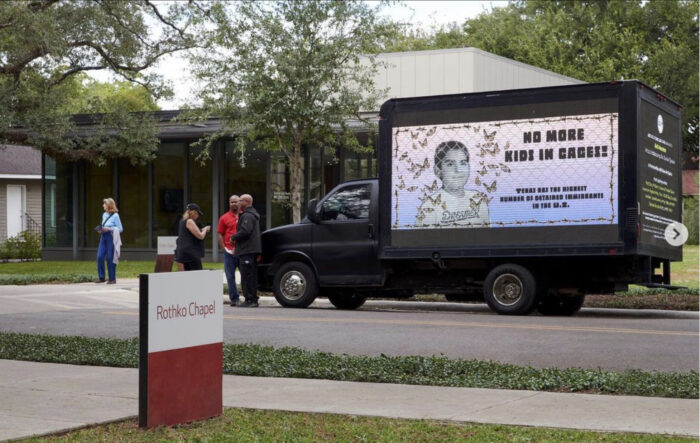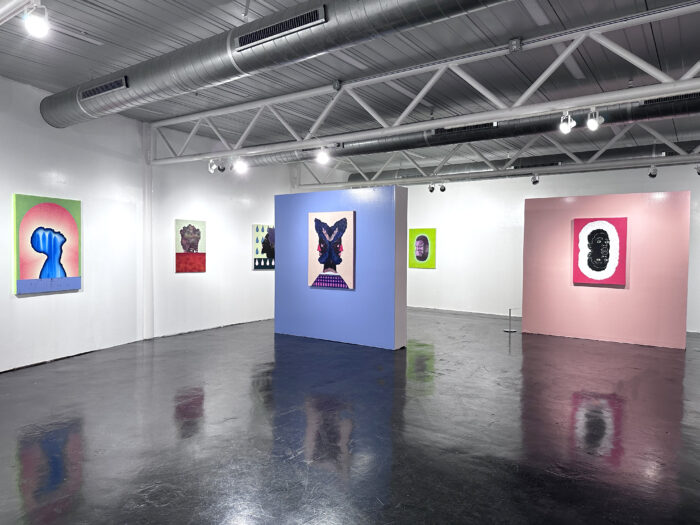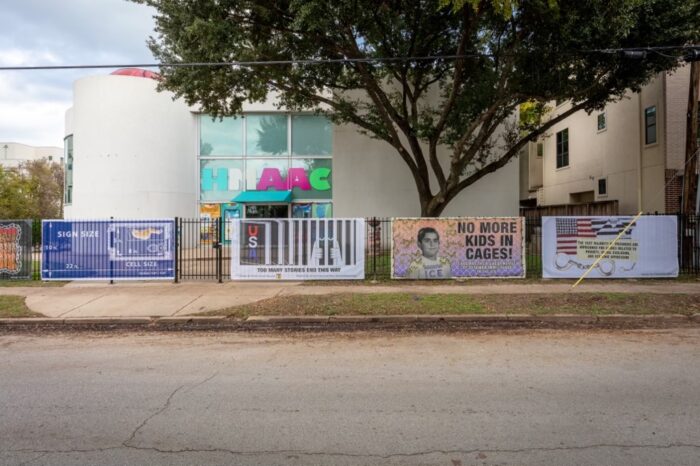Houston, Texas
“Artists play a pivotal role in shaping societal narratives. In the context of mass incarceration, they become the storytellers, the provocateurs who challenge norms and stimulate critical thinking. Their work transcends traditional boundaries, serving as a powerful medium to convey the human experience within the criminal justice system. Through these artist’s works, they themselves become advocates, sparking conversations that are essential for societal growth and transformation.”
Christopher Blay in conversation with Clare Gemima. Houston, Texas, 2023.

Courtesy of Art At A Time Like This.
8×5 Houston presented a poignant and timely artistic intervention in response to the mass incarceration crisis, focusing on the poor conditions imposed on those currently held in Harris County Jail in Houston, Texas. Art At A Time Like This, the nonprofit organisation headed by esteemed curators Barbara Pollack and Anne Verhallen, helps facilitate artists’s direct responses to current events. They curated an impressive route for the community of Houston to visually understand the crisis at hand, and aimed to raise awareness about the urgent issues surrounding the United State’s criminal justice system. Digitized images were installed on moving trucks that circuited around the community – mobile billboards that were driven and sometimes parked by the incredible Rothko Chapel Welcome House and the Contemporary Arts Museum of Houston, to name merely a few stations on its route.
The project, inspired by the name after the average prison cell size in the jail, features renowned artists like Mel Chin, Trenton Doyle Hancock, and Faylita Hicks, alongside selected contributors from an open call. The selection process involved key figures like Christopher Blay, the Chief Curator at the Houston Museum of African American Culture, who I was lucky enough to speak to in Houston earlier in the month.
Clare Gemima: Chris! Thank you so much for having me at the museum. It’s such a pleasure to get to talk to you. Could you delve into how the 8×5 Houston project addresses the incarceration crisis in Houston, and what makes it so unique?
Christopher Blay: Absolutely! The 8×5 Houston project is truly a unique exploration of the mass incarceration crisis. It serves as a dynamic fusion of art and activism, offering a distinctive platform for artists to voice their perspectives on the complex issue of Mass incarceration in Houston. What sets it apart is the raw authenticity artists bring to the table, reflecting the diversity of experiences and shedding light on the multifaceted aspects of the crisis.
Clare Gemima: The Houston Museum of African American Culture seems to have evolved significantly since its inception. Can you elaborate on the transformation of the museum and how it became a space to confront societal issues like mass incarceration?
Christopher Blay: The journey of the museum mirrors its physical and conceptual evolution. The museum has been in its current location since 2010. It is a building that started as a small house, and was expanded in 1999 – 2000 when HMAAC began as a museum in this location. This transformation wasn’t just about creating space; it was a conscious decision to align the museum with a commitment to engage with issues affecting Black people in Texas. It’s not just about the art on the walls; it’s about creating a living, breathing space that confronts and addresses societal challenges head-on.
Clare Gemima: In your four years of operating in Houston, how has the city’s dynamics influenced your perspective, especially concerning mass incarceration?
Christopher Blay: It has definitely been an eye-opening experience, to say the least. Houston, being a microcosm of Texas, has added layers to my understanding of mass incarceration in general. The sheer scale of the state amplifies the challenges we face, particularly in issues like mass incarceration. It’s not just a theoretical problem; it’s a lived reality that influences how we engage with, and respond to broader societal issues.

Clare Gemima: The 8×5 Houston project presents as a powerful intersection of art and activism. Can you share the criteria and process for selecting artists who you helped choose to contribute to this project?
Christopher Blay: Selecting artists for the 8×5 Houston project was a meticulous process alongside curators Bridget Bray and Ashley DeHoyos. It involved networking, scouting, and most importantly, aligning with artists who are passionately committed to addressing societal issues, particularly mass incarceration. The criteria extended beyond just artistic prowess; it was about finding individuals whose work reflected a genuine dedication to contributing to the ongoing conversation on these critical issues.
Clare Gemima: The museum’s Stairwell of Memory is a permanent exhibition addressing state violence. Could you tell me more about this presentation’s significance in the broader context of the museum’s mission?
Christopher Blay: The Stairwell of Memory holds immense significance in the broader context of the museum’s mission, as it stands as the museum’s only permanent exhibition. It serves as a tribute commemorating victims of state violence against Black people. This installation embodies our commitment to addressing and honoring the legacy of those affected by state violence, or police brutality. Every portrait tells a story, fostering an ongoing dialogue about the systemic issues we aim to confront.
Clare Gemima: Another exhibition at the museum features artist Johnny Floyd. Could you elaborate on this exhibition and artist?
Christopher Blay: Johnny Floyd’s exhibition, GODBODY, is a testament to the diverse and compelling narratives we aim to present at the Houston Museum of African American Culture. His work, deeply rooted in his Detroit-based perspective, brings a unique flavor to our museum. It is Floyd’s first solo museum exhibition. The selection process involved not just the visual appeal to his paintings, but a resonance with the stories and experiences that echo our commitment to amplifying a diverse range of voices. We want our audience to engage with narratives that may be unfamiliar, but are essential in broadening perspectives on African American arts and culture.

Clare Gemima: Moving beyond this particular project, what broader impact does the Houston Museum of African American Culture aim to have in addressing systemic issues?
Christopher Blay: The museum’s mission extends far beyond the confines of its physical space. We strive to be a catalyst for change, addressing systemic issues that affect the African American community in Texas and beyond. Through exhibitions, permanent installations, and community engagement, we aim to create awareness, provoke thoughtful discourse, and contribute to the broader societal transformation. It’s about being an active participant in shaping a more equitable and just future.
Clare Gemima: As someone who has been a part of the art ecosystem in various capacities, how do you perceive the role of institutions like yours in influencing necessary societal change?
Christopher Blay: Institutions like ours have a crucial role in influencing societal change. We aren’t just spaces that house art; we are platforms for advocacy, education, and reflection. By addressing societal issues head-on, we become agents of change. It’s about leveraging our position to amplify voices, challenge norms, and contribute to the ongoing narrative of societal transformation. Through art and engagement, we hope to inspire, provoke, and foster a more inclusive and just society.
 Clare Gemima: Given the current political and societal landscape, what challenges do you foresee in continuing this work, and how do you plan to navigate them?
Clare Gemima: Given the current political and societal landscape, what challenges do you foresee in continuing this work, and how do you plan to navigate them?
Christopher Blay: Navigating the current landscape poses challenges, especially when addressing sensitive and systemic issues. The potential for pushback is real, but it’s an inherent part of the process. We anticipate challenges in shifting narratives, but our commitment remains unwavering. By staying true to our mission, fostering community alliances, and adapting to the evolving landscape, we aim to overcome obstacles and continue driving meaningful change through our work.
Clare Gemima: Lastly, what message would you like to convey to those who may not be familiar with the Houston Museum of African American Culture and its impactful initiatives?
Christopher Blay: I would want people to see the Houston Museum of African American Culture not just as a museum but as a dynamic force for change. Our initiatives, from the 8×5 Houston project to permanent installations like the Stairwell of Memory, are testaments to our commitment to addressing societal issues. We invite everyone to engage, participate, and be a part of this transformative journey. It’s more than a museum; it’s a vibrant hub for dialogue, reflection, and collective action.
A special thank you to Art At A Time Like This and Christopher Blay for facilitating this interview.

